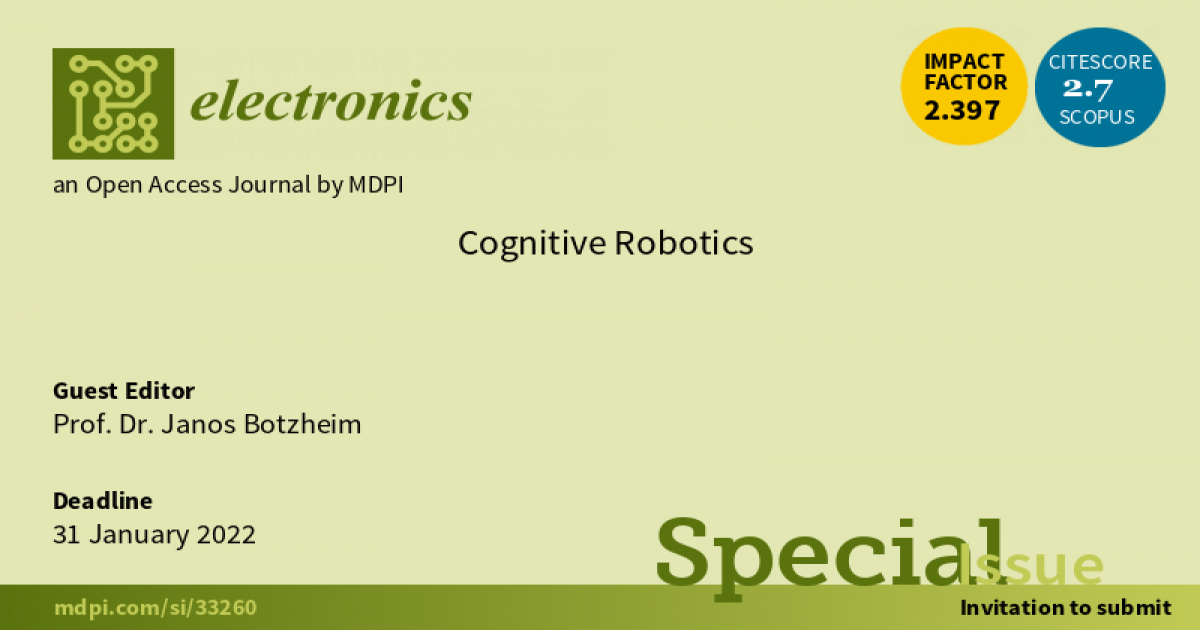Cognitive Robotics
A special issue of Electronics (ISSN 2079-9292). This special issue belongs to the section "Systems & Control Engineering".
Deadline for manuscript submissions: closed (31 January 2022) | Viewed by 22539

Special Issue Editor
Special Issue Information
Dear Colleagues,
Recently, various types of intelligent robots have been developed for the society of the next generation. In particular, intelligent robots should continue to perform tasks in real environments such as houses, commercial facilities, and public facilities. The growing need to automate daily tasks combined with new robot technologies are driving the development of human-friendly robots, i.e., safe and dependable machines, operating in close vicinity to humans or directly interacting with persons in a wide range of domains. The technology shift from classical industrial robots which are safely kept away from humans in cages to robots which will be used in close collaboration with humans requires major technological challenges that need to be overcome. Computational intelligence is very important to provide human-friendly services by robots. A robot should have human-like intelligence and cognitive capabilities to co-exist with people. The study on the intelligence, cognition, and self of robots has a long history. The concepts on adaptation, learning, and cognitive development should be introduced more intensively in the next-generation robotics from the theoretical point of view. Fuzzy, neural, and evolutionary computation play an important role in realizing the cognitive development of robots from a methodological point of view. Furthermore, the synthesis of information technology, network technology, and robot technology may bring the brand-new emerging intelligence to robots from a technical point of view. This Special Issue focuses on the intelligence of robots emerging from the adaptation, learning, and cognitive development through the interaction with people and dynamic environments from the conceptual, theoretical, methodological, and/or technical points of view.
Prof. Dr. Janos Botzheim
Guest Editor
Manuscript Submission Information
Manuscripts should be submitted online at www.mdpi.com by registering and logging in to this website. Once you are registered, click here to go to the submission form. Manuscripts can be submitted until the deadline. All submissions that pass pre-check are peer-reviewed. Accepted papers will be published continuously in the journal (as soon as accepted) and will be listed together on the special issue website. Research articles, review articles as well as short communications are invited. For planned papers, a title and short abstract (about 100 words) can be sent to the Editorial Office for announcement on this website.
Submitted manuscripts should not have been published previously, nor be under consideration for publication elsewhere (except conference proceedings papers). All manuscripts are thoroughly refereed through a single-blind peer-review process. A guide for authors and other relevant information for submission of manuscripts is available on the Instructions for Authors page. Electronics is an international peer-reviewed open access semimonthly journal published by MDPI.
Please visit the Instructions for Authors page before submitting a manuscript. The Article Processing Charge (APC) for publication in this open access journal is 2400 CHF (Swiss Francs). Submitted papers should be well formatted and use good English. Authors may use MDPI's English editing service prior to publication or during author revisions.
Keywords
- Robot intelligence
- Learning, adaptation, and evolution in robotics
- Human–robot interaction
- Embodied cognitive science
- Perception and action
- Intelligent robots
- Fuzzy, neural, and evolutionary computation for robotics
- Evolutionary robotics
- Soft computing for vision and learning





